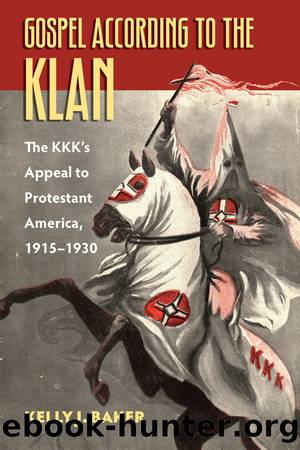Gospel According to the Klan by Kelly J. Baker

Author:Kelly J. Baker [Kelly J. Baker]
Language: eng
Format: epub
ISBN: 9780700624560
Publisher: University Press of Kansas
Published: 2017-01-09T00:00:00+00:00
CHAPTER 5
âWhite Skin Will Not Redeem a Black Heartâ:
The Klanâs Whiteness, White Supremacy, and American Race
We avow the distinction between the races of mankind as same has been decreed by the Creator, and shall be ever true in the faithful maintenance of White Supremacy and will strenuously oppose any compromise thereof in any and all things.
âH. W. EVANS (N.D.)1
The group minds of other races and other nations have developed differently from ours. Each nation has its own God-given qualities and its own mission: but each can do its own work only if the racial and group qualities, which depend upon the blood of the race itself, are preserved relatively pure. If any nation is mongrelized, that nation will lose its distinctive quality and its power to contribute to civilization.
âH. W. EVANS (1924)2
In the Imperial Night-Hawk, a Klan cartoon declared the âplanksâ of the movement for 1924. In the middle of the cartoon, a white-robed Klansman holding a fiery cross sat atop a similarly costumed horse. In the background, the sun was rising, which suggested a new day dawned for the order. Surrounding the archetype of a Klansman and radiating from the sun were the various issues the Klan supported, including Protestantism, clean politics, and restricted immigration. The Klan, as the cartoon indicated, was neither shy about its politics nor the love of race, but white supremacy was noticeably absent. Such was surprising because the 1920s Klan was historically infamous for its racial politics. White supremacy was a slogan of the order, so why was it excluded from the planks? On the other hand, in another cartoon from the Night-Hawk, an Irish figure and a small band comprised of two African American men marched down the streets of Atlanta. All were grossly stereotyped with exaggerated racial features. The âNegroâ figures wore marching band attire and almost appeared to be in blackface. The Irishman appeared as a Leprechaun with a jaunty hat and a flag in hand. Lining the streets were thousands of robed Klansmen who appeared ready to menace or attack the interlopers in the Southern city. The caption read, âSt. Patrickâs Day in Atlanta, Georgia,â and the cartoon implied that the Klan, at best, was unhappy with the small parade as the white-robed figures grimaced in frustration.
Life magazine originally published that particular cartoon to poke fun at Klansmen, but the order employed it to comment on race. The order did not appreciate or respect nonwhites. Moreover, as the cartoon made apparent, the figures signified a threat to the wider American culture. The cartoon signaled the orderâs view of race in general and the uplifting of the whiteness of members. In the 1924 cartoon, the ideal Klansman, surrounded by rays of light, indicated the beginning of a new era in which white supremacy would reign (even though white supremacy had already been a force in American cultural currents). The cartoon rendered the Irish and the Negro as backward races who lauded a foreign holiday. All of the figures seemed ignorant of the dominance of the white men who happened to be masked and robed.
Download
This site does not store any files on its server. We only index and link to content provided by other sites. Please contact the content providers to delete copyright contents if any and email us, we'll remove relevant links or contents immediately.
Christian Ethics for a Digital Society by Kate Ott(737)
Fearfully and Wonderfully Made by Philip Yancey & Paul Brand(720)
The World from 1450 To 1700 by Wills John E.;(692)
God and the Multiverse by Victor J. Stenger(633)
Numbers by Ronald B. Allen(590)
How to Read Slowly by James W. Sire(574)
Christian Ethics: An Introduction to Biblical Moral Reasoning by Wayne Grudem(569)
Morality by Jonathan Sacks(523)
Monastic Archaeology by Unknown(508)
The Technological System by Jacques Ellul(497)
Amish Grace by Donald B. Kraybill & Nolt Steven M. & Weaver-Zercher David L(484)
The Disabled Church by Rebecca F. Spurrier;(481)
Jesus: A New Vision by Whitley Strieber(480)
Children of Lucifer; The Origins of Modern Religious Satanism by Ruben van Luijk(474)
The City of God by Saint Augustine & Marcus Dods(468)
Death of the Doctor by Unknown(466)
Critical Writings by Joyce James;(465)
Redeeming Sociology by Vern S. Poythress(455)
The Church in the Early Middle Ages by G.R. Evans(433)
